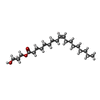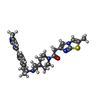+ Open data
Open data
- Basic information
Basic information
| Entry | Database: PDB / ID: 7f83 | ||||||
|---|---|---|---|---|---|---|---|
| Title | Crystal Structure of a receptor in Complex with inverse agonist | ||||||
 Components Components | Growth hormone secretagogue receptor type 1,Soluble cytochrome b562 | ||||||
 Keywords Keywords | SIGNALING PROTEIN / GPCR / Ghrelin / Inverse agonist | ||||||
| Function / homology |  Function and homology information Function and homology informationgrowth hormone secretagogue receptor activity / regulation of hindgut contraction / regulation of growth hormone secretion / positive regulation of small intestinal transit / negative regulation of locomotion involved in locomotory behavior / growth hormone-releasing hormone receptor activity / regulation of gastric motility / response to follicle-stimulating hormone / regulation of transmission of nerve impulse / ghrelin secretion ...growth hormone secretagogue receptor activity / regulation of hindgut contraction / regulation of growth hormone secretion / positive regulation of small intestinal transit / negative regulation of locomotion involved in locomotory behavior / growth hormone-releasing hormone receptor activity / regulation of gastric motility / response to follicle-stimulating hormone / regulation of transmission of nerve impulse / ghrelin secretion / positive regulation of appetite / growth hormone secretion / negative regulation of norepinephrine secretion / positive regulation of small intestine smooth muscle contraction / negative regulation of macrophage apoptotic process / positive regulation of eating behavior / adult feeding behavior / negative regulation of appetite / actin polymerization or depolymerization / positive regulation of multicellular organism growth / cellular response to thyroid hormone stimulus / response to growth hormone / regulation of postsynapse organization / positive regulation of insulin-like growth factor receptor signaling pathway / positive regulation of vascular endothelial cell proliferation / response to L-glutamate / negative regulation of interleukin-1 beta production / response to food / positive regulation of fatty acid metabolic process / response to dexamethasone / cellular response to insulin-like growth factor stimulus / regulation of synapse assembly / positive regulation of sprouting angiogenesis / regulation of neurotransmitter receptor localization to postsynaptic specialization membrane / decidualization / peptide hormone binding / negative regulation of interleukin-6 production / negative regulation of tumor necrosis factor production / postsynaptic modulation of chemical synaptic transmission / response to hormone / hormone-mediated signaling pathway / insulin-like growth factor receptor signaling pathway / synaptic membrane / Peptide ligand-binding receptors / electron transport chain / negative regulation of insulin secretion / G protein-coupled receptor activity / negative regulation of inflammatory response / Schaffer collateral - CA1 synapse / cellular response to insulin stimulus / response to estradiol / cellular response to lipopolysaccharide / spermatogenesis / G alpha (q) signalling events / learning or memory / electron transfer activity / periplasmic space / neuron projection / postsynapse / membrane raft / iron ion binding / G protein-coupled receptor signaling pathway / heme binding / glutamatergic synapse / cell surface / identical protein binding / plasma membrane Similarity search - Function | ||||||
| Biological species |  Homo sapiens (human) Homo sapiens (human) | ||||||
| Method |  X-RAY DIFFRACTION / X-RAY DIFFRACTION /  SYNCHROTRON / SYNCHROTRON /  MOLECULAR REPLACEMENT / Resolution: 2.94 Å MOLECULAR REPLACEMENT / Resolution: 2.94 Å | ||||||
 Authors Authors | Xu, Z. / Shao, Z. | ||||||
 Citation Citation |  Journal: Nat Commun / Year: 2022 Journal: Nat Commun / Year: 2022Title: Molecular mechanism of agonism and inverse agonism in ghrelin receptor. Authors: Jiao Qin / Ye Cai / Zheng Xu / Qianqian Ming / Su-Yu Ji / Chao Wu / Huibing Zhang / Chunyou Mao / Dan-Dan Shen / Kunio Hirata / Yanbin Ma / Wei Yan / Yan Zhang / Zhenhua Shao /   Abstract: Much effort has been invested in the investigation of the structural basis of G protein-coupled receptors (GPCRs) activation. Inverse agonists, which can inhibit GPCRs with constitutive activity, are ...Much effort has been invested in the investigation of the structural basis of G protein-coupled receptors (GPCRs) activation. Inverse agonists, which can inhibit GPCRs with constitutive activity, are considered useful therapeutic agents, but the molecular mechanism of such ligands remains insufficiently understood. Here, we report a crystal structure of the ghrelin receptor bound to the inverse agonist PF-05190457 and a cryo-electron microscopy structure of the active ghrelin receptor-Go complex bound to the endogenous agonist ghrelin. Our structures reveal a distinct binding mode of the inverse agonist PF-05190457 in the ghrelin receptor, different from the binding mode of agonists and neutral antagonists. Combining the structural comparisons and cellular function assays, we find that a polar network and a notable hydrophobic cluster are required for receptor activation and constitutive activity. Together, our study provides insights into the detailed mechanism of ghrelin receptor binding to agonists and inverse agonists, and paves the way to design specific ligands targeting ghrelin receptors. | ||||||
| History |
|
- Structure visualization
Structure visualization
| Structure viewer | Molecule:  Molmil Molmil Jmol/JSmol Jmol/JSmol |
|---|
- Downloads & links
Downloads & links
- Download
Download
| PDBx/mmCIF format |  7f83.cif.gz 7f83.cif.gz | 168.9 KB | Display |  PDBx/mmCIF format PDBx/mmCIF format |
|---|---|---|---|---|
| PDB format |  pdb7f83.ent.gz pdb7f83.ent.gz | 131.9 KB | Display |  PDB format PDB format |
| PDBx/mmJSON format |  7f83.json.gz 7f83.json.gz | Tree view |  PDBx/mmJSON format PDBx/mmJSON format | |
| Others |  Other downloads Other downloads |
-Validation report
| Summary document |  7f83_validation.pdf.gz 7f83_validation.pdf.gz | 1.8 MB | Display |  wwPDB validaton report wwPDB validaton report |
|---|---|---|---|---|
| Full document |  7f83_full_validation.pdf.gz 7f83_full_validation.pdf.gz | 1.8 MB | Display | |
| Data in XML |  7f83_validation.xml.gz 7f83_validation.xml.gz | 31.1 KB | Display | |
| Data in CIF |  7f83_validation.cif.gz 7f83_validation.cif.gz | 40.9 KB | Display | |
| Arichive directory |  https://data.pdbj.org/pub/pdb/validation_reports/f8/7f83 https://data.pdbj.org/pub/pdb/validation_reports/f8/7f83 ftp://data.pdbj.org/pub/pdb/validation_reports/f8/7f83 ftp://data.pdbj.org/pub/pdb/validation_reports/f8/7f83 | HTTPS FTP |
-Related structure data
| Related structure data | 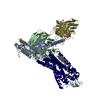 7w2zC  6ko5S S: Starting model for refinement C: citing same article ( |
|---|---|
| Similar structure data |
- Links
Links
- Assembly
Assembly
| Deposited unit | 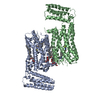
| ||||||||||
|---|---|---|---|---|---|---|---|---|---|---|---|
| 1 |
| ||||||||||
| Unit cell |
|
- Components
Components
| #1: Protein | Mass: 47183.223 Da / Num. of mol.: 2 / Mutation: T130K,N188Q,M1012W,H1107I,R1111L Source method: isolated from a genetically manipulated source Source: (gene. exp.)  Homo sapiens (human), (gene. exp.) Homo sapiens (human), (gene. exp.)  Gene: GHSR, cybC / Production host:  #2: Chemical | ChemComp-OLC / ( #3: Chemical | Has ligand of interest | Y | Has protein modification | Y | |
|---|
-Experimental details
-Experiment
| Experiment | Method:  X-RAY DIFFRACTION / Number of used crystals: 1 X-RAY DIFFRACTION / Number of used crystals: 1 |
|---|
- Sample preparation
Sample preparation
| Crystal | Density Matthews: 3.09 Å3/Da / Density % sol: 60.15 % |
|---|---|
| Crystal grow | Temperature: 293.15 K / Method: lipidic cubic phase / pH: 7 Details: 100mM HEPES, pH 7.0, 25%-36% PEG300, 80mM - 150mM NH4F |
-Data collection
| Diffraction | Mean temperature: 100 K / Serial crystal experiment: N |
|---|---|
| Diffraction source | Source:  SYNCHROTRON / Site: SYNCHROTRON / Site:  SPring-8 SPring-8  / Beamline: BL41XU / Wavelength: 1 Å / Beamline: BL41XU / Wavelength: 1 Å |
| Detector | Type: DECTRIS PILATUS3 6M / Detector: PIXEL / Date: Feb 7, 2021 |
| Radiation | Protocol: SINGLE WAVELENGTH / Monochromatic (M) / Laue (L): M / Scattering type: x-ray |
| Radiation wavelength | Wavelength: 1 Å / Relative weight: 1 |
| Reflection | Resolution: 2.94→39.78 Å / Num. obs: 25315 / % possible obs: 100 % / Redundancy: 24.53 % / Biso Wilson estimate: 81.38 Å2 / Rmerge(I) obs: 0.664 / Net I/σ(I): 10.37 |
| Reflection shell | Resolution: 2.94→3.12 Å / Redundancy: 23.68 % / Rmerge(I) obs: 5.083 / Mean I/σ(I) obs: 1.31 / % possible all: 100 |
- Processing
Processing
| Software |
| ||||||||||||||||||||||||||||||||||||||||||||||||||||||||||||||||||||||
|---|---|---|---|---|---|---|---|---|---|---|---|---|---|---|---|---|---|---|---|---|---|---|---|---|---|---|---|---|---|---|---|---|---|---|---|---|---|---|---|---|---|---|---|---|---|---|---|---|---|---|---|---|---|---|---|---|---|---|---|---|---|---|---|---|---|---|---|---|---|---|---|
| Refinement | Method to determine structure:  MOLECULAR REPLACEMENT MOLECULAR REPLACEMENTStarting model: 6KO5 Resolution: 2.94→39.78 Å / SU ML: 0.415 / Cross valid method: FREE R-VALUE / σ(F): 1.35 / Phase error: 26.565 Stereochemistry target values: GEOSTD + MONOMER LIBRARY + CDL V1.2
| ||||||||||||||||||||||||||||||||||||||||||||||||||||||||||||||||||||||
| Solvent computation | Shrinkage radii: 0.9 Å / VDW probe radii: 1.11 Å / Solvent model: FLAT BULK SOLVENT MODEL | ||||||||||||||||||||||||||||||||||||||||||||||||||||||||||||||||||||||
| Displacement parameters | Biso mean: 74.27 Å2 | ||||||||||||||||||||||||||||||||||||||||||||||||||||||||||||||||||||||
| Refinement step | Cycle: LAST / Resolution: 2.94→39.78 Å
| ||||||||||||||||||||||||||||||||||||||||||||||||||||||||||||||||||||||
| Refine LS restraints |
| ||||||||||||||||||||||||||||||||||||||||||||||||||||||||||||||||||||||
| LS refinement shell |
|
 Movie
Movie Controller
Controller




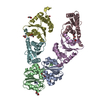
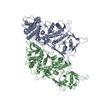
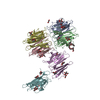
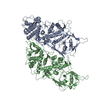
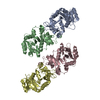
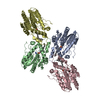

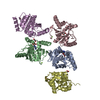
 PDBj
PDBj
















